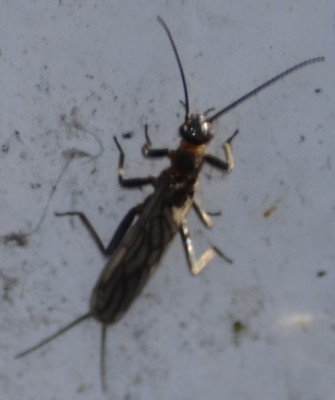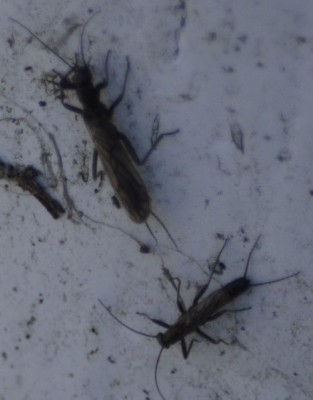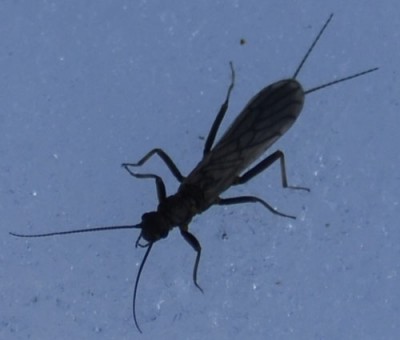On a sunny winter day in mid-February, I decided to ramble along the breakwater at Bronte Outer Harbour marina in Oakville, Ontario. It’s a great place to duck watch and to see swans in very undignified positions. The paths in the park are not maintained in the winter so there was lots of snow and ice and I had to watch my footing carefully. And that’s why I saw the insects on the snow.
Hundreds of Small Black Insects Walking on Top of the Snow on Tip Toes Near the Lake
Like anything else small and somewhat creepy once you see one, you realize they are everywhere. There were literally hundreds of these insects determinedly walking across the snow. At least some of them had wings because I did see one or two flying. However almost all of them were walking, some of them quite quickly.
At the end of the western breakwater I leaned against the cement retaining wall to take some photos of a pair of Common Mergansers and about 30 Greater Scaup. I happened to glance down at the light pole beside me and was promptly grossed out. It was seething with these same insects.
The insects are fairly long about the length of my baby fingernail.(About 7 mm, 1/4 inch.) They are very narrow, maybe 1 or 2 mm, less than a grain of rice to look at. As I discovered when I had to kill one that I had accidentally brought home and into the house with me, they are soft and easy to squish.
What Kind of Insect Walks On Snow Near Lakes in Winter?
A quick search online for snow and insects suggested they are Winter Snowflies. Looking at the photos on BugGuide.net made it conclusive. There are many different species of Snowflies, so I don’t know what kind we have in Oakville. In fact, one of my photos showed two insects of quite different sizes so we might have more than one species out there. (They are also sometimes called Winter Stoneflies.)
What Food Can They Find Among the Ice and Concrete?
Now part of the reason why I didn’t feel comfortable with the Winter Snowflies when I first saw them was I was preoccupied with what they were eating. There were only two strong possibilities on the breakwater itself: the, er, poop left behind by dogs (which there was pleasantly little of, by the way) or the occasional gull or other bird that succumbed to the harsh winter (I didn’t actually see any of those either, but I’m sure there must be some around.) The next idea was that they were some relative of the black fly which also hatches out en masse from very cold spring water.
I was quite relieved to discover that they actually eat vegetation. In fact, according to BugGuide the adults eat blue green algae in the lake, of which there certainly was lots. I hadn’t realized these were aquatic insects temporarily up on shore.
Mid-February is the Time for Love for Winter Snowflies
So if they weren’t ashore for food, why were they there? Well, pretty much for the same reason sailors have always come ashore even after the vessel is provisioned. The males were looking for the ladies. From the sheer number of insects I saw, I suspect most of them found a friend eventually.
I was also surprised to read that the Winter Snowflies are not just trying to get a head start on spring. These insects actually live opposite to most others. They sleep in the summer when it’s hot, and get active in the fall and winter when it’s cold. One advantage this gives them, according to The Xerces Society article, is that there are fewer predators especially birds and dragonflies around. That certainly was true that February afternoon. There were lots of ducks, swans and geese out and about, but not much else, not even many gulls. There were no flocks of ravenous flycatchers or warblers.
So the next time I see the Winter Snowflies swarm I will probably look on them with a more benign eye. Algae-eating insects who won’t even let snow cool their ardor are not something to be afraid of. In fact it’s kind of cute, in a bug-ugly way.
Further Information
Related Reading
Join In
Have you ever seen Winter Snowflies? What did you think? Please share your experiences with a comment.





Thanks for this, I was worried they were earwigs.
I guess we will be seeing those later in the spring too, sorry to say.